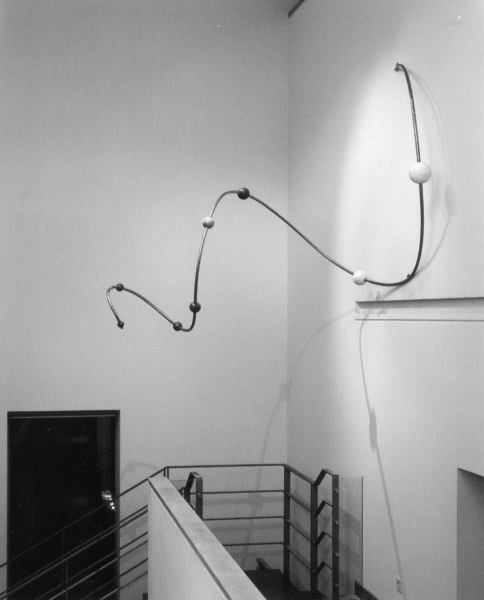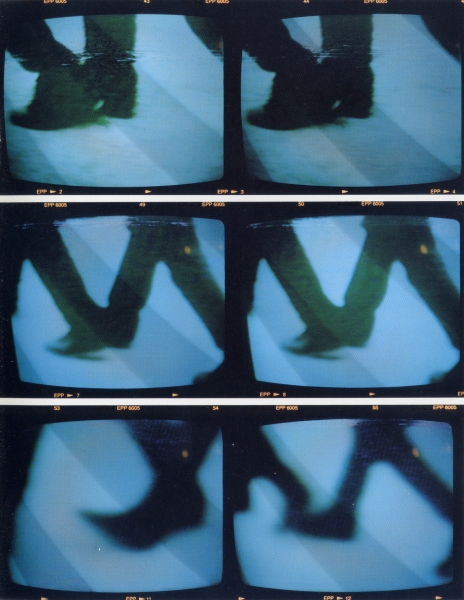
Ângela Ferreira: Escala (1995)
© DGPC
Bar Gallery
entry: General ConditionsUma Escala, uma Sequência, o Engenho da Deriva e um Filme Retardado
Ângela Ferreira
1995-11-24
1996-03-18
Curatorship: Pedro Lapa
Angela Ferreira's time machines
The work of Angela Ferreira has, since the outset, been marked by a need to diffuse the boundaries between artistic genres. However, this feature assumes an operative specificity of prime importance in her works. The relationship established between the photographic or graphic image and the three-dimensional experience of sculptural objects creates a set of formal complicities where the high culture, to which modernism was confined, finds its manifestation in objects of everyday use, particular to the popular culture of post-industrial societies. The ambiguity established between a possible aesthetic dimension inscribed in the formalism of the objects, or an aesthetically conditioned eye suggesting this ambiguity, raises a phenomenological question which deconstructs the formalism underpinning the processes through which these works are made. The question of the relationship between the formalism of the works, with their historic time, and their ahistoric appearance, defines the decisive question which is at play here — that of the process of modernization, the reflections thereby created in an already estranged time and its inertia after the constitutive utopia of the project.
It this way, Angela Ferreira's present installation, A Scale, A Sequence, A Derivative Machine and A Retarded Film, questions a central problem of its own production which is time. This was also the issue with which the artist chose to tackle a collection where Portuguese modernity and its peripheral specificities constitutes a dominant theme. An iconic structure of schematic value underlies each of the works. Thus, in Scale, over and above the appropriation of an obvious graphic feature, a period of time – that covered by the collection of Museu do Chiado – is stated as well as a linear and mechanic understanding. This one is followed by another, containing a modernist connotation which A Sequence couterpoints. The increased perceptual value of the materials and of formal qualities of abstract descent should not hide a conceptual depth which is totally diverse. Here, parallel to the usual sequence of traditional materials, a Hegelian sence of spiraling time is announced. As a criticism of this teleological time, A Derivative Machine reappropriates and adapts industrial materials, cites the arquitecture surrounding it, whilst almost erasing its presence, thus establishing a parallel between two unsynchronized situations which unilateraly divide the concept of time presented in the previous work. The times of modernity are thereby political divided between centres and peripheries. In A Retarded Film, by operating the passage from figuration to abstraction and by replacing synchronicity through the movement of the steps, the work shapes a tendential and terminal movement of modernism. The material rarification achieved by the unfocused image, allied to the deceleration, presupposes almost an extinction of time.
Thus, an ambiguity is forged between a modernist spatial utopia associated with radical freedom, and the undefined quality of a blind movement reducing differences to sameness, in a mode which is appropriate to the non-place of virtuality. All the same, the sense of the virtual, which substitutes a notion of utopia, may also be positively divided. This, in the end, happens with the whole installation, by making possible a rhetorical historicizing mechanism. As no pure space exists outside of theory, the conceptualization of historic routes in modernism is made through residual forms, and here the sublime is the virtual reality.
On Exhibition
The Ascension of Mont Ventoux
Manuel Valente Alves
2025-10-26
2026-02-16
Curatorship: Lúcia Saldanha
Photographs, drawings and paintings, by Manuel Valente Alves that develop a poetic dialogue with Petrarch's letter of the same name (Ascensus Montis Ventosi), written in 1336.
.
2025-10-16
2026-02-01
Curatorship: Susana Lourenço Marques, Emília Tavares
This exhibition, in partnership with the Porto Museum, presents the work of three amateur photographers - Margarida Relvas, Mariana Relvas and Maria da Conceição de Lemos Magalhães - developed in Portugal between 1860-1920.
Mily Possoz. A poetics of space
2025-10-01
2026-02-01
Curatorship: Emília Ferreira
The exhibition “Mily Possoz. A Poetics of Space” continues the research into the lesser-studied Portuguese modernists artists present in the collections of the MNAC and Millennium bcp.
Impressões Digitais. MNAC Collection
2024-12-12
2026-12-30
Curatorship: Ana Guimarães, Emília Ferreira, Maria de Aires Silveira e Tiago Beirão Veiga
Consisting of founding works of contemporary Portuguese art historiography, from 1850 to the present day, the MNAC's collection holds several national treasures.
Since 1911
2022-05-26
2026-05-26
An intervention that celebrates 110 years of the MNAC.












